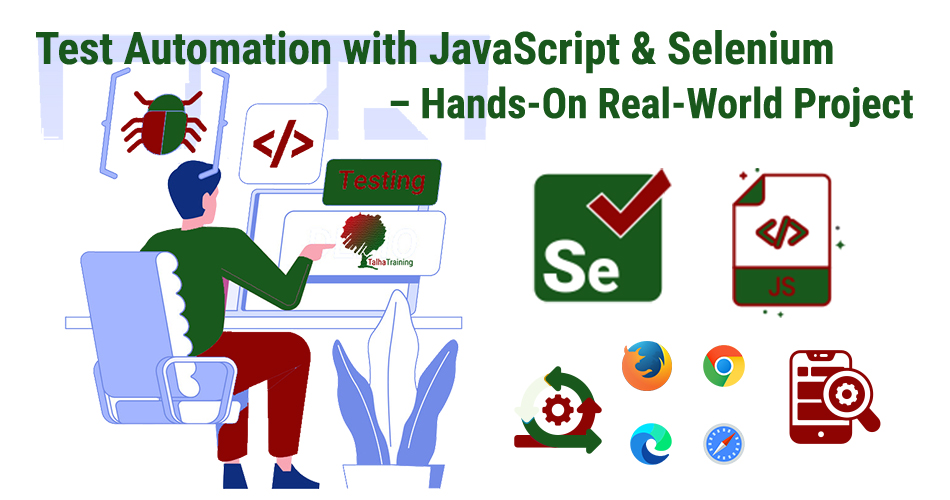Test Automation with JavaScript & Selenium – Hands-On Real-World Projects
Test Automation with JavaScript & Selenium – Hands-On Real-World Projects
What is Test Automation?
Test Automation is the process of using specialized tools and scripts to automate the testing of software applications. Instead of manually executing tests, automation allows us to simulate user interactions—like clicking buttons, filling out forms, or navigating pages—to verify if the software behaves as expected.
It ensures that your application is:
- Functionally sound
- Performance-optimized
- Reliable across updates and changes
By automating repetitive testing tasks, teams can save time, reduce human error, and ensure consistent results in less time.
Why Learn Test Automation?
Mastering test automation gives you a powerful edge in the world of software testing. Here’s why:
- Faster Testing Cycles – Run tests instantly and repeatedly.
- Improved Accuracy – Reduce the risk of manual errors.
- Efficiency Boost – Automate time-consuming tasks.
- Better Software Quality – Catch bugs early and ensure reliable releases.
- Global Career Edge – Automation testers are in high demand worldwide.
Why Learn JavaScript & Selenium?
JavaScript + Selenium is a dynamic duo for automating web testing:
- JavaScript is the language of the web—widely used, easy to learn, and extremely versatile.
- Selenium WebDriver is one of the most popular tools for automating browser-based applications.
Together, they allow you to:
- Automate real user scenarios across different browsers
- Write readable and maintainable test scripts
- Integrate easily with CI/CD pipelines
- Get hired faster with in-demand skills
Course Objective: Test Automation with JavaScript & Selenium
Ready to supercharge your web testing career? This course is designed to help you:
Build Real Test Automation Skills:
- Automate tests with JavaScript & Selenium WebDriver
- Simulate user actions like clicking, typing, and navigating
- Locate and interact with complex web elements using XPath and CSS
Enhance Testing Outcomes:
- Increase speed, accuracy, and efficiency
- Achieve broader test coverage across browsers and platforms
- Detect bugs faster and improve release cycles
Industry Integration:
- Use automation tools in real-world projects
- Integrate automated tests into modern CI/CD pipelines
Unlock Career Opportunities:
- Be job-ready for roles like:
- QA Automation Engineer
- SDET (Software Development Engineer in Test)
- Test Analyst
- Stand out with automation skills that employers value
Ready to level up your testing game?
Join the Test Automation with JavaScript and Selenium course and step into the future of smart, scalable, and stress-free software testing.
Module 1: Introduction to Test Automation
Objective:
To equip participants with a solid foundation in test automation—understanding its importance in modern software development, exploring common tools and scripting languages, and learning how to approach automation strategically and effectively.
Topics Covered
Test Automation Fundamentals
- What is Test Automation?
- Importance of automation in the Software Development Life Cycle (SDLC)
- Key benefits and limitations of automation testing
Automation Tools in Modern QA
- Overview of widely-used automation tools (e.g., Selenium, Appium, Cypress, etc.)
- Tool selection based on project requirements
- Role of automation frameworks in streamlining testing
Scripting Languages for Automation
- Comparison of commonly used scripting languages: Python, Java, JavaScript, etc.
- Why choose JavaScript? Advantages in terms of simplicity, readability, and community support
Planning & Strategy for Automation
- When should you automate? When not to automate?
- Criteria for selecting test cases for automation
- Developing an effective automation roadmap and strategy
Challenges & Best Practices
- Common challenges in implementing test automation
- Solutions and best practices for:
- Script maintainability
- Scalability
- Reusability
- Team collaboration
Automation Metrics & ROI
- How to measure success in automation projects?
- Key Performance Indicators (KPIs) for test automation
- Calculating Return on Investment (ROI) to justify automation efforts
Hands-On Introduction to Automation Tools
- Introduction to a selected automation tool (e.g., Selenium WebDriver)
- Live demonstration: Building a simple script to automate a web task
- Understanding basic tool capabilities (record-playback, scripting, debugging)
Outcome of Module 1:
By the end of this module, participants will be able to:
- Understand the value and purpose of automation in QA
- Identify suitable tools and languages for automation projects
- Strategically plan automation efforts aligned with business goals
- Begin hands-on work with basic automation tasks using industry tools
Module 2: JavaScript Fundamentals for Test Automation
Objective:
To build a strong foundation in JavaScript—focusing specifically on the concepts and techniques required for writing reliable and efficient test automation scripts. Participants will learn not only the language syntax but also how to write clean, maintainable, and test-friendly JavaScript code.
Topics Covered
Introduction to JavaScript
- Brief history and evolution of JavaScript
- Core features and ecosystem relevance for test automation
- Setting up your development environment:
- Installing js
- Choosing code editors and IDEs (e.g., VS Code)
- Writing and executing your first JavaScript program
Variables, Data Types, and Operators
- Declaring variables: var, let, and const
- Primitive data types: string, number, boolean
- Complex data types: array, object
- Operators:
- Arithmetic
- Assignment
- Comparison
- Logical
Control Flow and Functions
- Conditional logic:
- if, else if, else
- Looping techniques:
- for, while, ..while
- Functions:
- Defining and invoking functions
- Parameters, return values, and scope
- Arrow functions and anonymous functions
Arrays and Objects
- Working with arrays:
- Creating and accessing elements
- Iteration methods (forEach, map, filter)
- Understanding objects:
- Defining objects
- Accessing and modifying properties
- Adding methods to objects
- JSON Basics:
- Structure and usage in automation testing
DOM Manipulation (for UI Automation Contexts)
- What is the Document Object Model (DOM)?
- Selecting elements using:
- getElementById, querySelector, etc.
- Modifying content and attributes of DOM elements
- Handling browser events: click, input, change, etc.
Asynchronous JavaScript
- Why async matters in testing (AJAX, wait times, etc.)
- Callback functions
- Promises:
- Creating, chaining, and error handling
- Async/Await:
- Simplifying asynchronous test steps
Error Handling
- try-catch-finally blocks
- Handling exceptions and unexpected behavior
- Throwing custom errors to simulate test failure scenarios
Outcome of Module 2:
By completing this module, participants will be able to:
- Write clean and maintainable JavaScript code
- Understand and manipulate core JavaScript structures
- Apply asynchronous programming in test automation
Module 3: Selenium WebDriver with JavaScript
Objective:
Empower participants to master Selenium WebDriver using JavaScript for modern, maintainable, and scalable test automation. This module emphasizes hands-on practice with real-world tools and patterns like Page Object Model (POM), asynchronous operations, data-driven testing, and automation best practices—laying a strong foundation for professional success in the automation industry.
Topics Covered
Introduction to Selenium WebDriver
- What is Selenium WebDriver?
- Role of automation in modern software development
- Why use JavaScript for automation?
- Real-world use cases and advantages
Setting Up the Environment
- Installing and configuring:
- js and npm
- WebDriver Manager for Selenium
- Preferred IDEs (e.g., VS Code)
- Initial project setup and folder structure
WebDriver Basics
- Understanding key components:
- WebDriver, WebElement, and browser drivers
- Element locators:
- ID, Name, CSS Selectors, XPath, Class Name, Link Text
- Performing browser actions:
- Click, type, clear, submit, navigation
- Handling UI elements:
- Dropdowns, checkboxes, radio buttons, buttons
Asynchronous JavaScript for Selenium
- Async behavior in Selenium commands
- Using Promises, async/await, and callbacks
- Writing clean asynchronous test flows
Page Object Model (POM) Design Pattern
- Introduction to the POM architecture
- Creating and structuring page object files
- Reusability and maintainability benefits
- Writing test cases using POM
Handling Pop-ups and Alerts
- Managing JavaScript alerts, prompts, and confirmation boxes
- Switching between frames, iframes, and multiple windows
Data-Driven Testing
- Benefits of test parameterization
- Reading test data from:
- JSON
- CSV
- Excel files (using libraries like xlsx)
- Implementing data-driven test scenarios
Browser Interaction and Advanced Features
- Navigating through web pages
- Executing JavaScript directly in the browser
- Handling:
- File uploads
- Capturing screenshots
- Maximizing, resizing, and switching windows
Best Practices and Advanced Techniques
- Test logging and generating reports (e.g., with Allure or Mocha reporters)
- Exception handling and debugging strategies
- Optimizing test performance and code refactoring
- Strategies for cross-browser testing
Final Assessment & Certification
- Review of key automation concepts
- Practical assignments and theoretical quizzes
- Certificate of Completion upon successful evaluation
Capstone Project: Real-World Test Automation
- Automate a real-world web application
- End-to-end (E2E) test coverage: login, forms, navigation, validations
- Use of Page Object Model and asynchronous logic
- Generate execution reports
- Run tests via CLI or build tool
Best Practices & Career Tips
- Writing modular, reusable, and readable code
- Using Git for version control
- Introduction to CI/CD pipelines for test automation
- Overview of job roles and how to showcase your test automation skills to employers
Become Job-Market Ready with Real Automation Skills
This course is your gateway to unlocking the full potential of AI-powered automation using JavaScript and Selenium WebDriver. Whether you’re in QA, development, DevOps, freelancing, or test management, this training equips you to build automation frameworks, write real-world test scripts, and supercharge your testing career.
👉 Don’t just run tests—build frameworks, solve problems, and stand out globally!
Why Join This Course?
- 100% Hands-on Learning with Real Web Apps
- Industry-Relevant Projects using JavaScript & Selenium
- Learn POM, async/await, locators, automation patterns
- Globally Accepted Techniques
- Certificate of Completion
- Online Live + Offline Hybrid Mode Available
Course Features
- Mode: Live Online & Offline Classroom (Hybrid)
- Certificate: Provided after successful completion
- Tools: JavaScript, Selenium WebDriver, VS Code, Git, JSON, Excel
- Real Projects: Form testing, navigation, validation, data-driven testing, reporting
How to Enroll
Seats are limited! Confirm your enrollment by paying the course fee:
Bank Transfer Details:
- A/C Name: TalhaTraining
- A/C No.: 2141116000973
- Bank Name: Prime Bank Limited
- SWIFT Code: PRBLBDDH
- Routing Number: 170263614
After payment, please send us a confirmation email with your name, phone number, and payment slip.
Take the First Step – Register Now or Talk to Us for Guidance!
Have questions? Need help choosing the right path for your career in automation? Our friendly team is ready to help you—step by step.
📱 Call / WhatsApp: +8801712742217
📧 Email: training@talhatraining.com | talhatraining@gmail.com
🌐 Explore: talhatraining.com | hostbari.com
🌟 Your Automation Journey Starts Here!
Join our community of future-proof testers, engineers, and QA pros.
👥 Follow Us on:
YouTube | Facebook | Google | LinkedIn | Twitter | Instagram
💬 Comment “I’m Ready” below or inbox us to grab your seat now!

Discover Courses That Fit You
-
0 Lessons
-
0 Lessons
-
0 Lessons
-
0 Lessons



